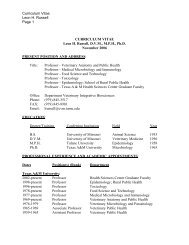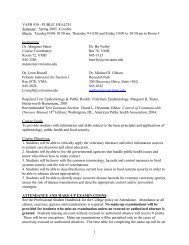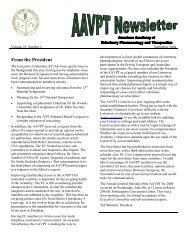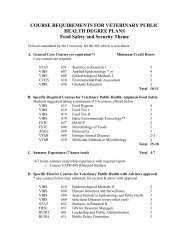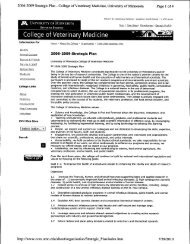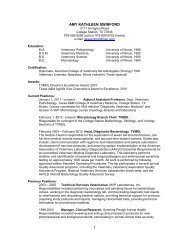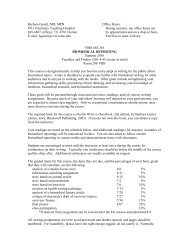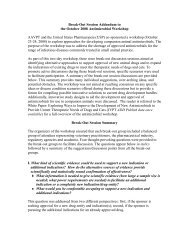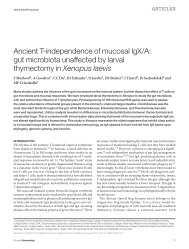Monteiro-Riviere NA - College of Veterinary Medicine
Monteiro-Riviere NA - College of Veterinary Medicine
Monteiro-Riviere NA - College of Veterinary Medicine
You also want an ePaper? Increase the reach of your titles
YUMPU automatically turns print PDFs into web optimized ePapers that Google loves.
Comparative Anatomical Factors<br />
Affecting Topical Delivery<br />
Nancy A. <strong>Monteiro</strong>-<strong>Riviere</strong>, Ph.D., Fellow ATS<br />
Pr<strong>of</strong>essor <strong>of</strong> Investigative Dermatology and Toxicology<br />
Center for Chemical Toxicology Research and Pharmacokinetics<br />
Department <strong>of</strong> Clinical Sciences<br />
<strong>College</strong> <strong>of</strong> <strong>Veterinary</strong> <strong>Medicine</strong><br />
North Carolina State University<br />
Raleigh, NC, 27606, USA<br />
Phone: (919) 513-6426 Fax: (919) 513-6358<br />
Nancy_<strong>Monteiro</strong>@ncsu.edu
Why talk about skin ?<br />
• Most visible organ in the body<br />
• Complexity <strong>of</strong> biology inherent to this “barrier<br />
organ” is <strong>of</strong>ten underestimated<br />
• Target <strong>of</strong> multi-billion dollar cosmetic industry<br />
• Skin is also a portal for entry <strong>of</strong> topically applied<br />
chemicals
Biological Functions <strong>of</strong> Skin<br />
• Physical and metabolic barrier to the environment :<br />
stratum corneum<br />
• Thermoregulation : hair and fur, apocrine and eccrine<br />
sweat glands, sebaceous glands and blood flow shunts<br />
• Mechanical Support : collagen and water<br />
• Endocrine (e.g., vitamin D)<br />
• Neurosensory reception<br />
• Immunologic responses : keratinocytes, Langerhans cells<br />
• Metabolism, Biotransformation<br />
• Uniquely exposed to UV light – sunburn
Cutaneous Biotransformation<br />
• Although P450 activity is less in skin, it can have a<br />
pr<strong>of</strong>ound effect on bioavailability<br />
• Phase I and II occur in basal layer<br />
• Applications<br />
• Prodrugs: conversion <strong>of</strong> lipid ester to free drug<br />
• detoxification <strong>of</strong> pesticides (parathion)<br />
• bioactivation <strong>of</strong> toxicants (benzo(a)pyrene)<br />
Minimal work published on species differences in<br />
absorption related to biotransformation!
Overview<br />
• Potential pathways for absorption<br />
• Species differences<br />
• Regional differences<br />
• Experimental model systems<br />
• Disease and alteration <strong>of</strong> the barrier
<strong>Monteiro</strong>-<strong>Riviere</strong> <strong>NA</strong>: Comparative Anatomy, Physiology, and Biochemistry <strong>of</strong> Mammalian Skin.<br />
In Dermal and Ocular Toxicology: Fundamentals and Methods (Ed. DW Hobson). CRC Press,<br />
Inc., New York, New York, Chapter 1, pp. 3-71, 1991.
Anatomical Considerations<br />
• Primary barrier to drug absorption is the stratum<br />
corneum<br />
• Composed <strong>of</strong> dead keratinocytes embedded in a lipid<br />
matrix, through which most drugs are absorbed<br />
• Lipid matrix excreted by cells in lower layer<br />
• Basal layer consists <strong>of</strong> viable keratinocytes which<br />
migrate to surface and are ultimately shed. Other cell<br />
types present:melanocytes, Merkel cells, Langerhans<br />
cells, etc.)<br />
• Dermis and vasculature
Menon and Fartasch. Structure and Functional Correlations <strong>of</strong> Skin Barrier. In Toxicology <strong>of</strong> the Skin-Target<br />
Organ Series. (Ed. <strong>NA</strong> <strong>Monteiro</strong>-<strong>Riviere</strong>). Informa Healthcare, NY, Vol. 29, Chapt. 10, 110-130, 2010.
Menon and Fartasch. Structure and Functional Correlations <strong>of</strong> Skin Barrier. In Toxicology <strong>of</strong> the Skin-Target<br />
Organ Series. (Ed. <strong>NA</strong> <strong>Monteiro</strong>-<strong>Riviere</strong>). Informa Healthcare, NY, Vol. 29, Chapt. 10, 110-130, 2010.
<strong>Monteiro</strong>-<strong>Riviere</strong> <strong>NA</strong>. Structure and Function <strong>of</strong> Skin. In Toxicology <strong>of</strong> the Skin-Target Organ<br />
Series. (Ed. <strong>NA</strong> <strong>Monteiro</strong>-<strong>Riviere</strong>). Informa Healthcare, NY, Vol . 29, Chapter 1, 1-18, 2010.
<strong>Monteiro</strong>-<strong>Riviere</strong> <strong>NA</strong>. Structure and Function <strong>of</strong> Skin. In Toxicology <strong>of</strong> the Skin-Target Organ<br />
Series. (Ed. <strong>NA</strong> <strong>Monteiro</strong>-<strong>Riviere</strong>). Informa Healthcare, NY, Vol. 29, Chapter 1, 1-18, 2010.
Interactions Between Solutes and Intercellular Lipids<br />
Grice, Zhang, Roberts. Chemical Structure- Skin Transport Relationships. In Toxicology <strong>of</strong> the<br />
Skin-Target Organ Series. (Ed. <strong>NA</strong> <strong>Monteiro</strong>-<strong>Riviere</strong>). Informa Healthcare, NY, Vol. 29, Chapt.<br />
6, 55-68, 2010.
Composition and Orientation <strong>of</strong> Stratum Corneum Lipids<br />
are Important Determinants <strong>of</strong> Barrier Function
Skin: PORTAL <strong>of</strong> Entry and TARGET for Toxicity<br />
IL-8, TNF α, Others<br />
SYSTEMIC EFFECT
<strong>Monteiro</strong>-<strong>Riviere</strong> <strong>NA</strong> and <strong>Riviere</strong> JE: Skin Toxicology In Toxicology, (Eds. H Marquardt,<br />
S Schafer, R McClellan, F Welsch), Academic Press, San Diego, CA, Chapt. 18, 439-457, 1999.
Target for immune localization and potential<br />
lymphatic transport are Langerhans cells located<br />
just beneath stratum corneum<br />
Absorption pass the epidermis is NOT required for a toxicological<br />
response. The same can be said for skin carcinogens.
AUTOPOIESIS<br />
Menon and Fartasch. Structure and Functional Correlations <strong>of</strong> Skin Barrier. In Toxicology <strong>of</strong> the Skin-Target<br />
Organ Series. (Ed. <strong>NA</strong> <strong>Monteiro</strong>-<strong>Riviere</strong>). Informa Healthcare, NY, Vol. 29, Chapt. 10, 110-130, 2010.
Dancik, Thompson, Krishnan, Roberts. Cutaneous Metabolism and Active Transport in<br />
Transdermal Drug Delivery. In Toxicology <strong>of</strong> the Skin-Target Organ Series. (Ed. <strong>NA</strong><br />
<strong>Monteiro</strong>-<strong>Riviere</strong>). Informa Healthcare, NY, Vol. 29, Chapt. 7, 69-82, 2010.
Importance <strong>of</strong> Lipid Biochemistry/ Biophysics<br />
• Removal <strong>of</strong> rate-limiting stratum corneum increases<br />
absorption<br />
• Intercellular lipids are the primary pathway for drug<br />
absorption<br />
• Consist primarily <strong>of</strong> ceramides, sterols, and other<br />
neutral lipids<br />
• Exist in a liquid-crystalline matrix, the fluidity <strong>of</strong> which<br />
is related to permeability <strong>of</strong> hydrophilic drugs<br />
• Temperature, hydration and chemical penetration<br />
enhancers increase fluidity and permeability
Absorption<br />
•Relates to the amount <strong>of</strong> chemical that penetrates<br />
the skin and then absorbed into the bloodstream to<br />
have a systemic effect.<br />
•Detected by flux into the perfusate or blood.<br />
Penetration<br />
•Relates to the amount <strong>of</strong> chemical that gets to<br />
targets within the skin and could be available for<br />
local cutaneous activity.<br />
•Detected by confocal microscopy, transmission<br />
electron microscopy, special stains, biopsies and tape<br />
stripping.
<strong>Monteiro</strong>-<strong>Riviere</strong> <strong>NA</strong>: Structure and Function <strong>of</strong> Skin. In Dermal Absorption Models in<br />
Toxicology and Pharmacology (Ed. JE <strong>Riviere</strong>). CRC, Taylor and Francis, Boca Raton, FL.<br />
Chapter 1. pp. 1-19, 2006.
<strong>Monteiro</strong>-<strong>Riviere</strong> <strong>NA</strong>: Integument. In Eurell J, Frappier B, eds. Dellman’s Textbook <strong>of</strong><br />
<strong>Veterinary</strong> Histology, Blackwell Publishing, Ames, Iowa, 6 th ed., pp.320-349, 2006.
<strong>Monteiro</strong>-<strong>Riviere</strong> <strong>NA</strong>: Integument. In Eurell J, Frappier B, eds. Dellman’s Textbook <strong>of</strong><br />
<strong>Veterinary</strong> Histology, Blackwell Publishing, Ames, Iowa, 6 th ed., pp.320-349, 2006.
<strong>Monteiro</strong>-<strong>Riviere</strong> <strong>NA</strong>: Integument. In Eurell J, Frappier B, eds. Dellman’s Textbook <strong>of</strong><br />
<strong>Veterinary</strong> Histology, Blackwell Publishing, Ames, Iowa, 6 th ed., pp.320-349, 2006.
<strong>Monteiro</strong>-<strong>Riviere</strong> <strong>NA</strong>: Integument. In Eurell J, Frappier B, eds. Dellman’s Textbook <strong>of</strong><br />
<strong>Veterinary</strong> Histology, Blackwell Publishing, Ames, Iowa, 6 th ed., pp.320-349, 2006.
<strong>Monteiro</strong>-<strong>Riviere</strong> <strong>NA</strong>. Ultrastructural Evaluation <strong>of</strong> the Porcine Integument. In Swine in<br />
Biomedical Research, Tumbleson ME (ed), NY, Plenum Press, vol 1.pp 641-655, 1986.
<strong>Monteiro</strong>-<strong>Riviere</strong> <strong>NA</strong>: Integument. In Eurell J, Frappier B, eds. Dellman’s Textbook<br />
<strong>of</strong> <strong>Veterinary</strong> Histology, Blackwell Publishing, Ames, Iowa, 6 th ed., pp.320-349, 2006
<strong>Monteiro</strong>-<strong>Riviere</strong> <strong>NA</strong>. Structure and Function <strong>of</strong> Skin. In Toxicology <strong>of</strong> the Skin-Target Organ<br />
Series. (Ed. <strong>NA</strong> <strong>Monteiro</strong>-<strong>Riviere</strong>). Informa Healthcare, NY, Vol . 29, Chapter 1, 1-18, 2010.




